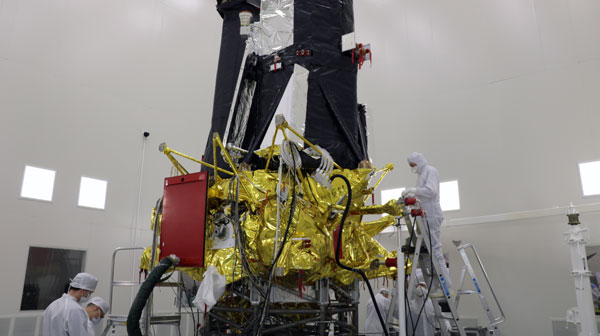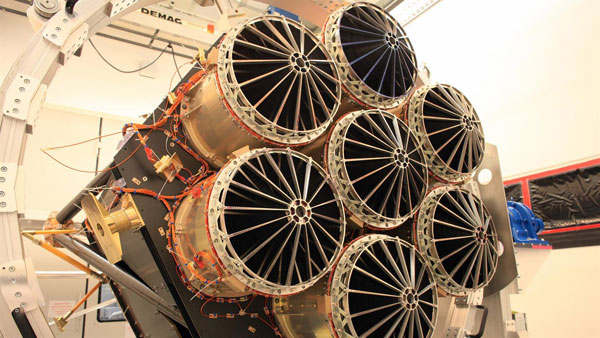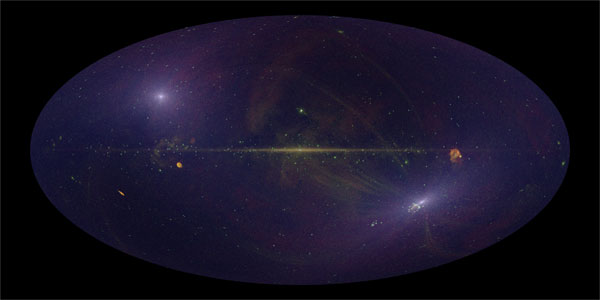Spektrum-Röntgen-Gamma, a long-delayed and much-modified X-ray astronomy package, launched successfully from the Kazakh Steppe on Saturday.
The Spektrum-Röntgen-Gamma (Spektr-RG) satellite took to the skies on Saturday, July 13th, at 17:31 local time (12:31 UT). The Proton rocket carrying the spacecraft launched from the Baikonur Cosmodrome on the Kazakh Steppe in Russia.
The launch will set Spektr-RG on its way for the next three months, until it reaches a stable solar orbit 1.5 million kilometers (1 million miles) from Earth, on the opposite side from the Sun. From there, two telescopes — one German and one Russian — will carry out investigations of the X-ray universe.

Roscosmos / DLR / SRG / Lavochkin
The Telescopes
X-rays penetrate most materials — including mirrors — so focusing them requires a unique design. Both the German space agency’s Extended Roentgen Survey with an Imaging Telescope Array (EROSITA) and the Russian Astronomical Roentgen Telescope - X-ray Concentrator (ART-XC) contain multiple modules of concentric mirror pairs. X-rays skip off two mirrors at grazing incidence angles, like smooth pebbles off a pond, coming to a focus on the X-ray detectors.
Each of EROSITA’s seven “eyes” contains 54 mirror pairs, nested inside each other like Russian dolls. These mirrors focus X-rays onto CCD detectors with 18-arcsecond resolution. Such images won’t have the sub-arcsecond quality of, say, a Hubble or Chandra image, but on the other hand the images will cover the entire X-ray sky. Indeed, EROSITA will survey the full sky not just once, but eight times over four years. Compared with the last all-sky survey, conducted with the ROSAT mission in the 1990s, EROSITA will have 25 times the sensitivity. It will discover sources never seen before — by the millions.
“EROSITA will map the entire sky in X-rays up to 10 keV for the first time,” says team member Esra Bulbul (Center for Astrophysics, Harvard & Smithsonian). “The science span of eROSITA is remarkably wide. It will detect large number of X-ray transients, supernova remnants, galaxies, clusters of galaxies, filaments connecting clusters, and the warm-hot intergalactic medium.”

P. Friedrich / MPE
Like EROSITA, the Russian ART-XC contains seven mirror modules, though with fewer mirror shells inside each one: 28 instead of 54. Complementing the lower-energy photons that EROSITA is sensitive to (200 to 10,000 electron volts), ART-XC will focus higher X-ray energies, from 5,000 to 30,000 electron volts. The two overlap in the middle, which will aid the calibration of both instruments. The trade-off for ART-XC’s sensitivity to higher energies will be its fuzzier images, with a resolution of 45 arcseconds. It will also have a narrower field of view.
In an example of Russian-American collaboration, NASA’s Marshall Space Center developed and calibrated ART-XC’s mirror systems. These were then installed at the Russian Federal Nuclear Center in Sarov, Russia, where the telescope was built.
Probing Dark Energy with X-ray Vision
The primary science goal for EROSITA, and one of the targets of ART-XC, is to better characterize dark energy, the unknown force that’s determining the universe’s expansion rate and ultimate fate. EROSITA’s survey is expected to pick up 100,000 galaxy clusters, with which astronomers will study the nature of this mysterious force.
Clusters of galaxies represent the largest gravitationally bound structures in the universe. Stars make up only 1% or so of the cluster’s matter, and EROSITA won’t see the stars anyway. Instead, the telescope will detect clusters by the X-rays coming from the tenuous but abundant gas swirling between galaxies. Where a visible-light telescope sees a galaxy cluster as a collection of points of light, EROSITA will see an X-ray blob. But, importantly, EROSITA will see these blobs out to incredible distances.

T. Dauser / Remeis-Observatory / FAU / EROSITA Team
In the 1990s, ROSAT measured X-rays from nearby galaxy clusters, determining that “normal” matter (that is, the baryonic matter that makes up stars, planets, and you and me) makes up about 30% of the universe’s total matter. Beginning in mid-October, EROSITA will start making the observations to extend that measurement to when the universe was half its current age. By cataloging galaxy clusters that far back, astronomers can measure changes in large-scale structure over cosmic time.
The Mission That Could
Today marks the triumphant conclusion of Spektr-RG’s long journey to the launchpad. Born in the 1990s, the mission was set aside during a Russian economic downturn before being resuscitated in 2005. The revived mission was smaller and incorporated more international cooperation, but still suffered a series of delays from an original launch date of 2011.
On its decade-long journey to the launchpad, EROSITA had its share of speedbumps, too. “I haven’t counted the sleepless nights over the last 10 to 12 years,” says Principal Investigator Peter Predehl (Max Planck Institute for Extraterrestrial Physics, Germany). “Whenever I thought I was out of the woods, the next one would come.”
EROSITA’s mirrors, which are scaled-down versions of those flown aboard the XMM-Newton satellite, turned out to be more difficult to scale than originally thought. Then the satellite electronics quickly turned complicated. “Electrical engineers are a nightmare for any who has to manage such a project,” Predehl says, tongue firmly in cheek. “They can’t be controlled, they do not follow any order, and they do what the want — but what they do is excellent.”
Now that the mission is finally launched, anticipation is high. “After the commissioning and calibration, we will have the first light — this always a special and holy moment for the principal investigator,” Predehl says.
But first light only marks the beginning: “We cannot expect to get breaking science news very soon,” Predehl notes. “But it will be exciting to see the sky being slowly covered.” All of its observations, he adds, will be made available in real-time. After four years of sweeping the X-ray sky, EROSITA will dedicate another three years to targeted observations. Watch the video below to learn more about EROSITA and its mission:
 2
2
Comments
BobW
July 19, 2019 at 5:38 pm
Something is wrong in the video about EROSITA: Talking about the Lagrange points, L2 is shown outside earth's orbit, lined up with sun and earth. In that position the gravitational forces from sun and earth maximally add, not cancel out as described.
Bob Wilson
You must be logged in to post a comment.
Warren-Odom
July 21, 2019 at 10:54 pm
"Cancel out" kind of glosses over some of the finer details. It's not that there are no gravitational forces there, but the united gravity plus centripetal force of orbital motion (with probably a bit of help from station-keeping thrusters) combine to more or less hold an object in relative place, as opposed to being drawn into an orbit around one of the larger bodies. https://en.wikipedia.org/wiki/Lagrangian_point
You must be logged in to post a comment.
You must be logged in to post a comment.